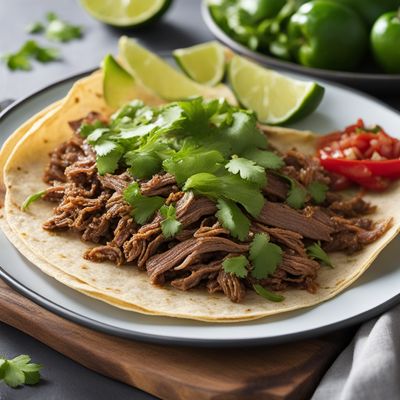
Ingredient
Tomatillos
The Tangy Green Gems
Tomatillos are small, spherical fruits that are covered in a papery husk. They have a bright green color and a slightly sticky texture. When ripe, they are firm and juicy, with a tangy and slightly citrusy flavor. The husk is removed before using the tomatillos, revealing the smooth and shiny skin. They are often used to add a tangy and refreshing element to dishes, especially in Mexican and Southwestern cuisines.
Origins and history
Tomatillos have a long history in Mexican cuisine, dating back to ancient times. They were cultivated by the Aztecs and were an important part of their diet. Tomatillos are native to Mexico and Central America, and they have been used in traditional Mexican dishes for centuries. Today, they are also grown in other parts of the world, including the United States. They are often associated with Mexican cuisine, but they are also used in other Latin American and Southwestern dishes.
Nutritional information
Tomatillos are low in calories and fat, and they are a good source of vitamin C and vitamin K. They also contain fiber and antioxidants, which are beneficial for overall health.
Allergens
There are no known allergens associated with tomatillos.
How to select
When selecting tomatillos, look for ones that are firm and bright green in color. Avoid tomatillos that are soft, wrinkled, or have brown spots. The husks should be dry and intact. Choose tomatillos that are medium-sized, as they tend to have a better flavor. If possible, give them a gentle squeeze to ensure they are firm and not mushy.
Storage recommendations
To store tomatillos, remove the husks and place them in a paper bag or a perforated plastic bag. Store them in the refrigerator for up to two weeks. Avoid washing them until you are ready to use them, as excess moisture can cause them to spoil faster.
How to produce
Tomatillos can be grown in a home garden or in containers. They require full sun and well-drained soil. Start by planting the seeds indoors and transplant them outside once the danger of frost has passed. Provide support for the plants as they grow, as they can become top-heavy. Harvest the tomatillos when they are firm and fully ripe, with a bright green color.
Preparation tips
To prepare tomatillos, remove the husks and rinse them under cold water to remove any sticky residue. Cut them into quarters or halves, depending on the recipe. Tomatillos can be used raw in salsas, salads, or ceviche. They can also be roasted, grilled, or boiled to bring out their natural sweetness and mellow their tartness. They are commonly used to make salsa verde, a tangy and flavorful green sauce that pairs well with grilled meats, tacos, and enchiladas.
Substitutions
Green tomatoes can be used as a substitute for tomatillos, although they have a slightly different flavor. If you don't have access to fresh tomatillos, you can also use canned tomatillos, which are readily available in most grocery stores.
Culinary uses
Tomatillos are commonly used in Mexican cuisine to make salsa verde, enchiladas, and pozole. They are also used in soups, stews, and sauces. Their tangy flavor adds a refreshing element to dishes and balances out rich and spicy flavors. They are often paired with ingredients like chilies, onions, garlic, and cilantro.
Availability
Tomatillos are commonly available in Mexico, the United States, and other Latin American countries. They are also cultivated in some parts of Europe and Asia.
More ingredients from this category
Recipes using Tomatillos » Browse all

Pepita con Tasajo with Roasted Tomatillo Salsa
Savory Pumpkin Seed and Beef Stir-Fry with Tangy Tomatillo Sauce

Machaca Tacos with Salsa Verde
Savory Shredded Beef Tacos with Tangy Green Salsa

Gorditas de Huevos with Salsa Verde
Savory Mexican Egg-Stuffed Gorditas

Pescado con Tres Salsas
Flavors of the Sea: Pescado con Tres Salsas

Bistec Picado with Salsa Verde
Savory Mexican Beef Stir-Fry with Tangy Green Sauce

Codzitos with Salsa Verde
Crispy Codzitos: A Flavorful Twist on Traditional Mexican Delight

Haute Green Chileatole
Elevated Green Chileatole: A Sophisticated Twist on a Mexican Classic

Enchiladas Potosinas with Tangy Salsa Verde
Savory Stuffed Enchiladas with a Zesty Green Sauce

Guatemalan Green Chicken Stew
Verde Delight: A Flavorful Guatemalan Chicken Stew

Authentic Mexican Green Pozole
Zesty Green Pozole: A Burst of Mexican Flavors

Icelandic-style Tomato and Bread Soup
Hearty Tomato and Bread Soup with a Nordic Twist

Authentic Mexican Mole Poblano
Spicy Chocolate Delight: Authentic Mexican Mole Poblano Recipe

